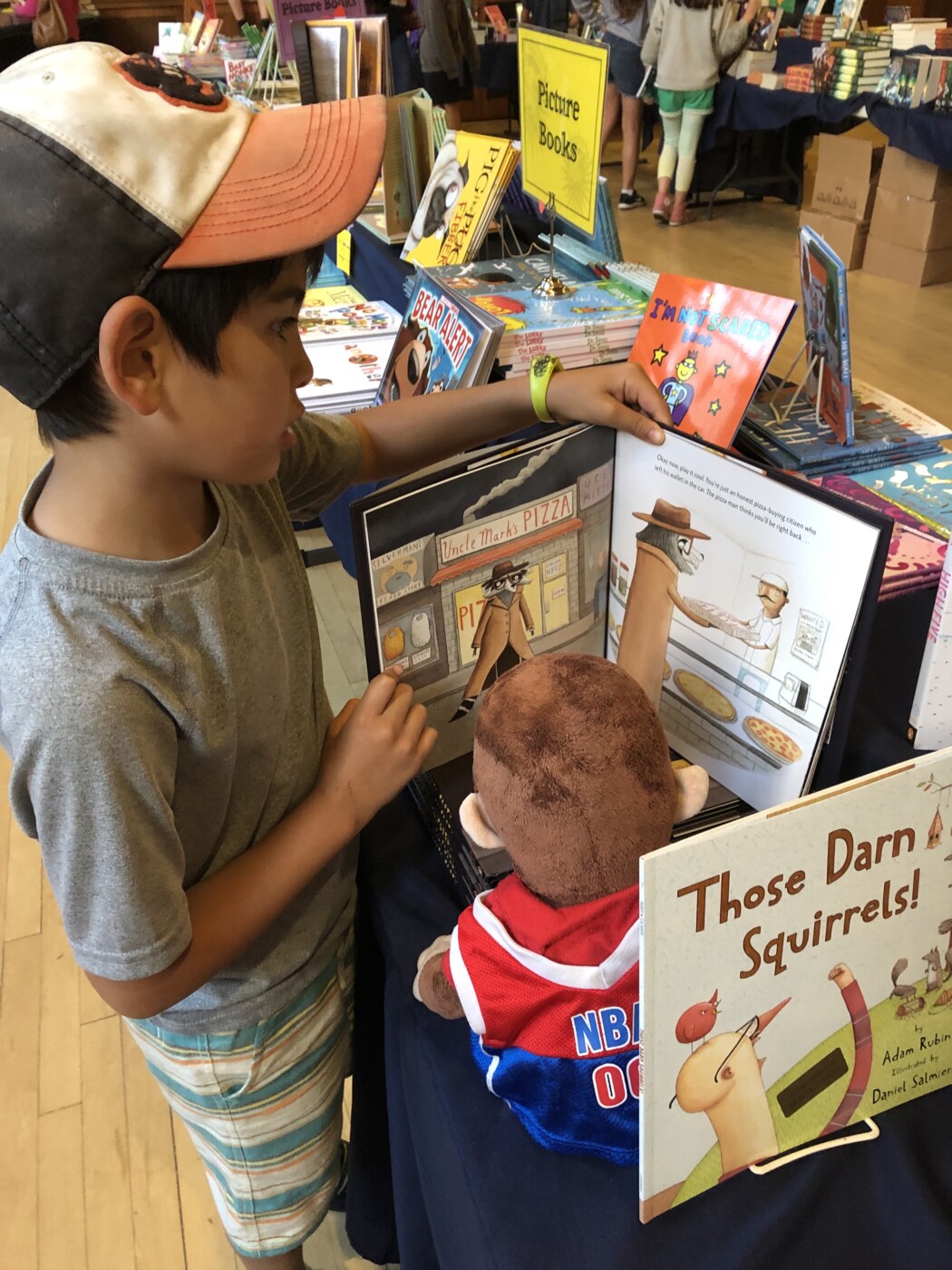Against a backdrop of plummeting test scores and grim pandemic learning loss, the science of reading has been gaining traction, but literacy experts warn there are myriad challenges ahead. Solving the literacy crisis will require far more than just teaching more phonics.
Many states and cities are embracing the idea that reading should be taught in a way that reflects what we know about the brain, and how it connects letters with sounds when learning to read. This understanding is at the core of the science of reading, an approach backed by decades of exhaustive scientific research. New York City now mandates research-based curriculums. And while California has not adopted a statewide reading curriculum, its reading guidance to districts supports the science of reading, and the state will be adopting universal dyslexia screening by 2025.
All are attempts to grapple with the escalating literacy crisis, which has worsened in the wake of the pandemic. Last year, almost 60% of California’s third graders could not read at grade level. National reading scores are also falling, according to last year’s National Assessment of Educational Progess, or NAEP, a situation that many literacy advocates characterize as a tragedy, arguing that literacy is a civil right too many children are denied.
Yet despite this growing momentum toward reform, many literacy experts warn that many serious obstacles, from the ubiquity of balanced literacy, which avoids phonics in favor of fostering a love of reading, to inadequate teacher training and the proliferation of screens, lie ahead before a transformation in American reading instruction is likely to take root.
Many experts fear that as the pandemic recedes from view, and abysmal test scores, which disproportionately affect low-income students, come to seem normal, the intense attention to the literacy crisis may begin to fade.
“Sadly, I don’t think that much will change once the recent flurry of rhetoric dies down,” said Austin Beutner, former Los Angeles Unified superintendent.
“One learns to read in elementary school so they can read to learn thereafter. Is there anything more important academically than early literacy? Schools won’t make much progress unless and until all stakeholders in any public school community, elected officials, school board members, superintendents and even families, make it the No. 1 priority that it must be.”
One major obstacle to change is that the science of reading is often misunderstood, experts say, to mean just the teaching of phonics, how to sound out words. Amid the battle over phonics, experts warn that too little attention has been paid to other key reading skills, such as background knowledge and vocabulary, that also drive comprehension. There is also an emerging concern that some kids may not learn to read as well if they are constantly toggling back and forth from page to screen. Even if the debate over whether phonics is necessary is finally winding down, there are many other battles to be waged on the science of reading front. On the heels of a longstanding national debate known as “the reading wars,” misconceptions about the science of reading may have dire consequences.
“I am worried that people are getting so focused on phonics instruction that they’re overlooking equally serious problems with comprehension instruction,” said Natalie Wexler, author of “The Knowledge Gap,” warning that phonics alone won’t boost test scores. “If we don’t build foundational skills and knowledge simultaneously, then the pendulum may swing away from phonics once again.”
Being aware of how the brain works, how teachers can most effectively fuel comprehension, from phonics to books on paper, may be key to navigating the literacy crisis. At the core of many of these debates is a shaky grasp of what cognitive science tells us about how children learn. You can’t just teach phonics and expect kids to become nimble readers.

“You have to tackle all of the strands of reading,” said Jessica Reid Sliwerski, a former teacher and CEO of Ignite Reading, a Zoom-based reading tutorial. “All of it matters, and all of it has to be done well.”
Among the other core aspects of teaching reading are background knowledge and vocabulary. These must be woven together with phonics to make reading instruction effective, experts say.
The barriers to change are daunting. Many teachers have curriculum fatigue. Against the backdrop of bitter labor disputes, spiraling student misbehavior and escalating teacher burnout, teachers may not have the bandwidth to change the way they think about phonics, vocabulary, background knowledge and use of screens in the classroom. They may stick with what they’re used to, experts say, which is balanced literacy.
This is one reason many districts in California and across the country espouse balanced literacy, an approach popularized by Lucy Calkins in her influential “Units of Study” curriculum that often downplays phonics in favor of trying to instill a love of reading, experts say, often encouraging children to guess at words using picture clues rather than sound them out. Change will be hard-won, some warn.
“There is unlikely to be any large movement with a consistent impact on teaching or learning,” said Timothy Shanahan, a literacy expert and professor emeritus at the University of Illinois at Chicago. “Tangible changes may be made here and there, but they may cancel each other out or be so poorly administered that they simply don’t matter.”
Inadequate teacher training remains a critical issue. Many educators remain fond of balanced literacy, experts say, and many teacher training programs gloss over the science of reading.
“The folks who are against phonics, they still hold sway at many universities,” said Shanahan, who helped lead the influential National Reading Panel which concluded that phonics-focused curriculums align with how the brain learns to read. “So it is possible that teacher preparation will continue to ignore phonics and other elements of reading.”
A growing lack of background knowledge may be another danger. Desperate to buttress falling math and reading scores, many schools have cut back on critical subjects like science and history to focus on literacy and numeracy. That strategy appears to have backfired, setting off a freefall in all subject areas, such as history and civics, as the abysmal NAEP scores reveal. A staggering 87% of eighth graders are below proficient in history and 78% fail to hit the mark in civics, yet many say they saw this coming.
“I don’t think it’s surprising that we are looking at pretty dismal data,” said Los Angeles Unified Superintendent Alberto Carvalho, suggesting that more effective reading instruction would free up time for other key subjects. “We ought to ask the question, have we placed enough attention and efforts on civics education, on social studies, on history? I think there’s been a preponderance of emphasis on literacy and numeracy at the expense of other areas.”
The trouble is that children need a stored cache of basic facts and concepts, a working understanding of the world, before they can tackle nuanced academic text.
Without the context to unlock its meaning, say proponents of the burgeoning Knowledge Matters push, a part of the science of reading movement, vital information can sound like noise. If you don’t know that the U.S. won its independence from Great Britain during the American Revolution, then the War of 1812 is unlikely to make much sense to you.
“The more knowledge kids have,” said Sliwerski, “the more they can apply that knowledge to make meaning of increasingly complex texts.”
That’s why cutting back on history and other subjects is a double-edged sword, some experts warn. Limiting children to leveled reading groups, often below their grade level, also curbs the accumulation of knowledge. Some say that dynamic may also imperil comprehension, leading to falling test scores.

“Teachers need to look at how well their students are reading,” said Sue Pimentel, one of the nation’s top K-12 literacy experts and one of the lead authors of the Common Core state standards. “They have to take responsibility if their students are not reading well by any number of objective measures. … I think the pressure will eventually build. The problem is that generations of children may be hurt. That makes my heart hurt.”
The key may be to teach history and science and other subjects from the earliest grades. Even little kids should be reading engaging stories about history and science, experts say, or having those stories read to them. History doesn’t have to be dry. Think of the beloved “Who Was?” series.
Focus on the substance of what kids need to know. If a text is too complicated for some children to parse on their own, many experts suggest that read-aloud can engage strong and weak readers alike.
Like many aspects of academic achievement, this is an equity issue, experts say, because families of means have the time and resources to build knowledge at home or through extra classes and tutors. These parents are providing the glue that helps knowledge stick.
“Knowledge is like Velcro,” said Wexler. “It sticks best to other related knowledge. Some kids are starting out with more of that Velcro, more of that knowledge of the world, academic knowledge and vocabulary. And they’re not only reading at a higher level, they’re also able to retain more new information from what they’re reading.”
In literacy circles, this phenomenon is often referred to as the Matthew effect, in that the rich get richer. But since so few teachers see reading skill and background knowledge as two sides of the same coin, there’s been little push to revamp how we teach comprehension.
“Assumptions about comprehension instruction are so deeply entrenched that the usual prescription for falling reading scores is to just double down on what we’re already doing rather than trying something new,” said Wexler. “The phonics stuff is easier for people to grasp, because it’s more familiar and it’s simpler. You teach a kid to decode, and voila, she can read a simple book. When you build knowledge, it takes a lot more time to see the results.”
Part of the problem may be the assumption that if you can simply Google “the Civil War,” why bother to study it? That kind of shortcut may help explain why Wexler found many high school students confuse the “Civil War” period with the “Civil Rights” era. In fact, research suggests that we have a tendency to forget information that we easily look up on the Internet, often referred to as the “Google effect.”
Those dire NAEP history scores should ring an alarm bell, experts say, warning us that uneducated citizens may well be ill-prepared to participate in democracy. Last year’s eighth graders are now in high school, after all, on the cusp of adulthood.
“Unless we do something to grab their interest and advance their reading competence, they will soon enter college and the workforce with extremely limited knowledge about American democracy and our history,” as Pimentel puts it. “That’s a grave threat to our nation.”
Yet another pressing issue is that some schools, seeking to fast-track learning amid plunging test scores, may have leaned too heavily on technology as a magic bullet.
As with the phonics debate, the key may lie in understanding how the brain is wired, particularly the plasticity of the developing mind, which is still building its reading circuitry. Mounting research suggests there is a processing difference when reading on screen that inhibits careful reading.
“For years, studies have found that students learn more from reading paper than reading screens, and yet we live in an increasingly digital world, a trend unlikely to change,” said Shanahan. “Screen reading tends to be more like skimming than reading.”
Certainly, if children read more deeply in print, as much research suggests, then even if we fix all the other low-hanging issues facing literacy (for instance, if we teach phonics and eschew guessing) there’s another potential threat looming: All those screens in the classroom may be unwittingly undermining the kind of “deep reading” we associate with an educated individual.
“Ed tech is not what children need all day at all,” said neuroscientist Maryanne Wolf, author of “Reader, Come Home: The Reading Brain in a Digital World. “I am dismayed at the regressions in children during Covid when people thought tech was going to be able to give the kids enough.”
Not only do physical books foster focus (there are no pings distracting you), experts say, but they also fuel the development of deep reading processes. Screens invite us to skate along on the surface of the ideas, to browse and scroll, instead of digging deeper into the quarry of concepts.
“The critical relationship between the quality of reading and the quality of thought is influenced heavily by changes in attention,” as Wolf, director of the UCLA Center for Dyslexia, Diverse Learners, and Social Justice, puts it.
“The screen actually hastens us along by the very characteristics of the device.”
The evidence is piling up. In one study, children showed more activity in the language centers of the brain when reading with an adult than when listening to an audiobook. When they read on an iPad, the brain activation was the least of all. In another, brain scans showed stronger reading circuits in children who spent more time reading books. Research also suggests that comprehension suffers when children read on screen. Unfortunately, many teachers are unaware of this dynamic.
“Most teachers see screens vs. text as a motivation issue and are unlikely to be aware that students don’t comprehend as well on one or the other,” said Shanahan.
Given the relentless pace of technology, there’s no way to keep children away from the ever-widening sphere of screens, but some experts suggest that parents and teachers should be more mindful of how technology may affect cognition. This is critical, they say, if we want students to engage in the kind of deep reading that fuels intellectual curiosity.
“We must not let go of deep reading as one of the major goals and aspirations for our young,” Wolf said. “Deep reading is what allows us to have a kind of sanctuary inside ourselves, a place where our thoughts can meet other people’s thoughts and release our best thinking, our insights, our epiphanies, our ability to reflect.”
One suggestion is embracing slowness so that the brain can actually digest what it’s reading, instead of hurtling along to the next embedded link. In a sense, we may need to find ways to make the screen work more like a book.
“I suspect readers need to learn to adjust how they read screens to avoid the superficiality of their reading,” Shanahan said. “I’ve been trying to slow my roll as a reader, and it’s very hard to fight the impulse to zoom. Doable but hard. I suspect it’s much worse for children.”
